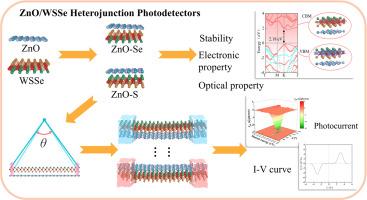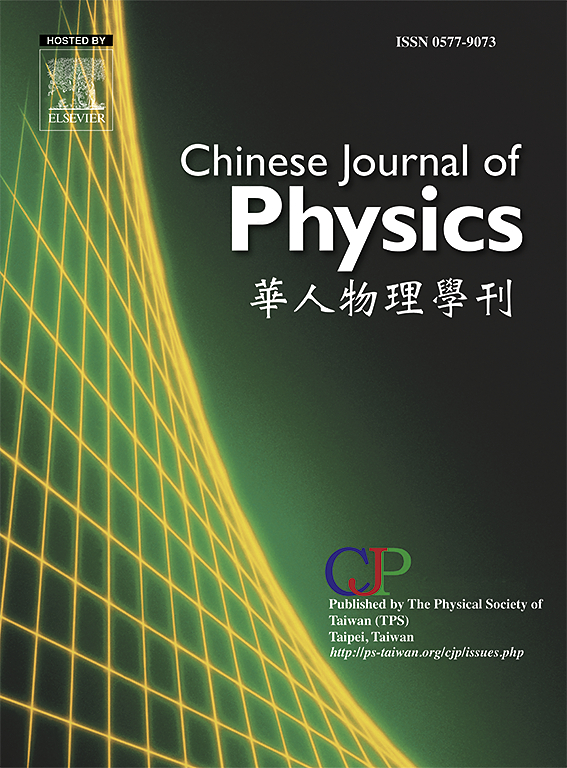Performance modulation of ZnO/WSSe heterojunction photodetectors via longitudinal stress bending
IF 4.6
2区 物理与天体物理
Q1 PHYSICS, MULTIDISCIPLINARY
引用次数: 0
Abstract
In the practical application of photodetectors, they are often subjected to external bending forces. To explore the influence of stress bending, this study constructed a novel heterojunction ZnO/WSSe with two configurations: ZnO-Se and ZnO-S. The stability of these heterojunctions was confirmed through calculations of formation energy, phonon spectrum analysis, and AIMD simulations. Electronic property studies revealed different band configurations. ZnO-Se exhibited a type-I heterojunction with a bandgap of 2.18 eV, while ZnO-S formed a type-II heterojunction with a bandgap of 1.88 eV. Despite the same composition, different interface states led to different electrostatic potentials. Optical property analysis indicated that both heterojunctions had enhanced light absorption compared to the intrinsic materials. The heterojunction photodetectors demonstrated significant photocurrent response and exhibited a negative differential resistance effect in their I-V characteristics, indicating different turn-on voltages. Longitudinal stress bending experiments further showed effective modulation of photocurrent response and I-V characteristics, highlighting mechanical stress engineering as a means to enhance performance. In summary, these findings highlight the potential of ZnO-Se and ZnO-S heterojunctions in optoelectronic applications.

利用纵向应力弯曲调制ZnO/WSSe异质结光电探测器的性能
在光电探测器的实际应用中,它们经常受到外部弯曲力的作用。为了探究应力弯曲对ZnO/WSSe的影响,本研究构建了一种具有ZnO- se和ZnO- s两种结构的新型异质结ZnO/WSSe。通过形成能计算、声子谱分析和AIMD模拟,证实了这些异质结的稳定性。电子特性研究揭示了不同的波段结构。ZnO-Se为i型异质结,带隙为2.18 eV, ZnO-S为ii型异质结,带隙为1.88 eV。虽然组成相同,但不同的界面状态导致不同的静电势。光学性质分析表明,与本征材料相比,这两种异质结都增强了光吸收。异质结光电探测器表现出明显的光电流响应,其I-V特性表现出负差分电阻效应,表明不同的导通电压。纵向应力弯曲实验进一步显示了光电流响应和I-V特性的有效调制,突出了机械应力工程作为提高性能的手段。总之,这些发现突出了ZnO-Se和ZnO-S异质结在光电应用中的潜力。
本文章由计算机程序翻译,如有差异,请以英文原文为准。
求助全文
约1分钟内获得全文
求助全文
来源期刊

Chinese Journal of Physics
物理-物理:综合
CiteScore
8.50
自引率
10.00%
发文量
361
审稿时长
44 days
期刊介绍:
The Chinese Journal of Physics publishes important advances in various branches in physics, including statistical and biophysical physics, condensed matter physics, atomic/molecular physics, optics, particle physics and nuclear physics.
The editors welcome manuscripts on:
-General Physics: Statistical and Quantum Mechanics, etc.-
Gravitation and Astrophysics-
Elementary Particles and Fields-
Nuclear Physics-
Atomic, Molecular, and Optical Physics-
Quantum Information and Quantum Computation-
Fluid Dynamics, Nonlinear Dynamics, Chaos, and Complex Networks-
Plasma and Beam Physics-
Condensed Matter: Structure, etc.-
Condensed Matter: Electronic Properties, etc.-
Polymer, Soft Matter, Biological, and Interdisciplinary Physics.
CJP publishes regular research papers, feature articles and review papers.
 求助内容:
求助内容: 应助结果提醒方式:
应助结果提醒方式:


